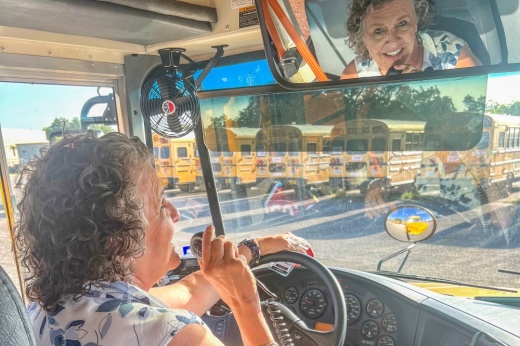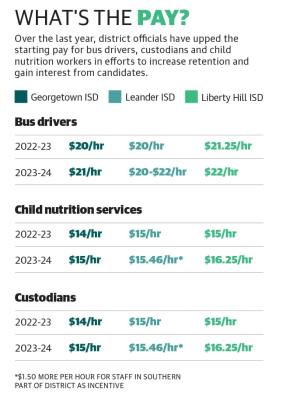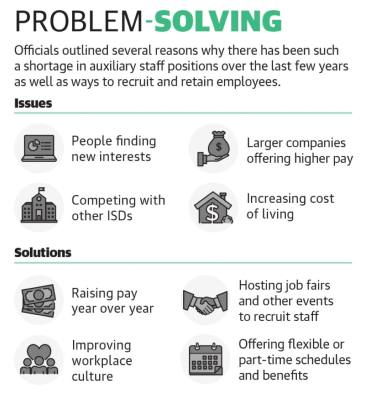Both Leander and Liberty Hill ISDs are experiencing auxiliary worker shortages, forcing the districts to adapt and make do with the staff they do have so programs and services are not interrupted.
Molly Alexander, a long-term bus driver in Liberty Hill ISD, said the respect and regard for bus drivers and other auxiliary positions alike has diminished over the years.
She said 20 years ago, it was difficult to get a job working in school-support positions, such as a bus driver. Now, school districts are finding it hard to fill those positions.
It’s been an ongoing issue for LISD as Superintendent Bruce Gearing said the district is still working to fill its ranks in the transportation, custodial, food service and maintenance departments heading into the 2023-24 school year.
“We continue hiring throughout the year as well, but we never really are fully staffed in any of those areas throughout the year,” Gearing said.
Spread thin
Roughly a month before school started, LISD was in need of 50 bus drivers and 100 child nutrition services staff members, meaning more than 50% of these positions were vacant.
In LHISD, only one of the district’s 12 custodial positions were filled. Additionally, 60% of the district’s bus driver positions and 33% of its child nutrition positions were vacant.
“All of these support roles, they also impact the classroom,” said Gloria Gonzales-Dholakia, a LISD parent and the board of trustees president. “If you can’t get your students to campus on time, that impacts the classroom. If they don’t have enough staff to prepare a healthy meal, that impacts the classroom.”
School officials said they believe a combination of factors has resulted in the staffing shortages, pointing to cost-of-living increases, competition from other districts and industries, and a declining workforce. State lawmakers also ended this year’s regular legislative session without allocating more dollars to public schools, making it difficult for districts to keep up with the demands of the job market.
LISD bus driver and trainer Terry Williams has been with the district for 12 years. He took on the position because he was looking for a flexible work schedule, but he quickly grew to love what he does and began learning Spanish so he could better communicate with bilingual students and their families.
“I realized right away I needed to start [learning Spanish], but about 2014 is when it all catapulted. I decided I want to sleep, eat, drink and pray in Spanish,” Williams said. “Now I’m able to communicate with them in their mother tongue.”
Williams said the market for drivers with a commercial driver’s license is competitive. He remembers 10-12 bus drivers quitting last year to go operate dump trucks.
“They were paying three times what we pay here,” Williams said. “Families that are in situations where they have financial demands, they have to find another resource.”
LHISD is struggling to fill bus driver and custodial positions more than other auxiliary ones. Chief Operations Officer Mark Willoughby attributes some of these shortages to the COVID-19 pandemic.
“People have found new interests or have decided they want to work a certain amount or a certain way,” he said. “I just think it’s a creative challenge for everybody to get people to come back to work and to work efficiently and productively in a manner that would replicate what happened before.”
Market conditions
LHISD Superintendent Steven Snell said districts have also lost staff to larger corporations and businesses, such as Kalahari Resorts & Conventions-Round Rock, Samsung and Tesla.
He said despite the district offering a more flexible schedule, the higher pay at these large companies makes it hard for the district to compete.
“We’re restricted on our pay, and it becomes an arms race,” Snell said. “There’s a lot going on in Austin, and there’s lots of opportunities for everybody. The more opportunities there are in the entire region, the more competitive prices get and the harder it is for schools to fill those positions.”
LHISD approved a compensation plan in June that includes a starting hourly pay of $22 for bus drivers and $16.25 for custodians. In the 2022-23 school year, the starting pay for bus drivers was $21.25 and $15 for custodians.
The LISD board of trustees approved a 4% wage increase for all employees in April.
Gearing said the pay bumps have not eliminated the staffing shortages altogether as inflation has increased and surrounding districts are providing similar raises. It has, though, allowed LISD to keep pace with the market, he said.
Gonzales-Dholakia said the cost of living can have a significant impact on districts such as LISD because staff can make about the same amount working in an area where homes and rental properties are cheaper. She said while the board left room for pay adjustments when it adopted the fiscal year 2023-24 budget—87% of which goes to employee wages—it hinges on the Texas Legislature allocating more funding to schools.
“I think if our state doesn’t do something significantly [to address] the pay gaps in public [education], we’re going to see these critical positions have vacancies throughout the entire system,” she said.
Creative solutions
Willoughby said it has required some thinking outside of the box to avoid asking staff to take on more responsibility and maximize existing resources.
“It has challenged us to make sure that we’re using our resources efficiently and making sure we’re meeting the greatest needs before others,” he said.
Willoughby said if LHISD has unfilled positions, officials will ask the staff to “step up and take on some additional responsibilities.”
LHISD has also begun working on bus routes and schedules to ensure students are arriving at school on time. In June, the district hired Director of Transportation Ann Hatton, who will lead the department through growth and address any route concerns.
LISD, meanwhile, changed its bell schedule to reduce the total number of routes. It’s created more work for the drivers, but it hasn’t affected the district’s bus service zone, Gearing said.
LISD has been using both traditional and unconventional methods to recruit workers as well. The district hosts regular job fairs and the transportation department participated in a “bus roadeo” last year—a statewide competition for drivers to showcase their abilities on an obstacle course.
Additionally, LISD is looking for parents and guardians to volunteer in the transportation department, where they would serve as crossing guards and phone operators. This is because some permanent staff who serve in those positions are often called out to drive buses.
Williams, who also helps recruit bus drivers, said he convinced two parents who live on his bus route to join the district’s fleet.
“They’re in their second and third year, and they’re loving it,” he said. “They realized that this is the first time they have been able to take a vacation together. So that’s attractive to a lot of our moms and dads that are coming on board.”
To attract and retain more employees, some districts in Central Texas have implemented programs to provide affordable housing. Round Rock and Pflugerville ISDs formed agreements with the Texas Workforce Housing Foundation to provide subsidized rents at local apartment complexes for their staff members.
Gonzales-Dholakia said she’s paying close attention to those types of housing initiatives but also pointed out the geographical difference, with Leander ISD spanning portions of two counties and five cities.
In the meantime, Gearing said the district’s top priority is ensuring these shortages have as little impact on students and campuses as possible.
“We absorb as much of the pain that we can at the administrative level, and we’re constantly thinking through what we can do to make better use of the staff that we do have,” he said.









